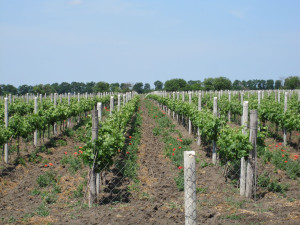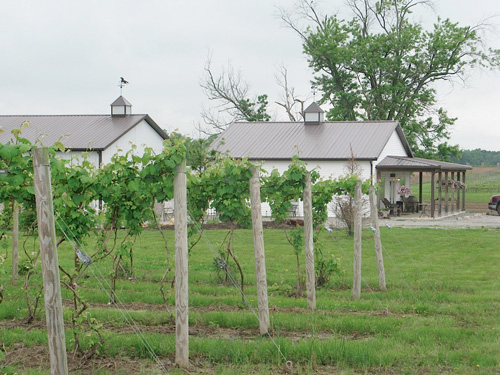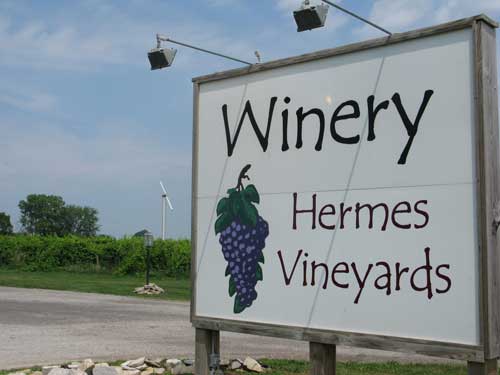We Need Something Harder Than Wood Trellis Posts
I began collecting data for this subject two years ago in response to the rapid growth of viticulture in Minnesota and other Northern regions. This article is based on my own experience of growing grapes in the Eastern European country, Republic of Moldova, combined with productive discussions on this topic through the grape breeders group, and supported with information from the internet.
What are the issues regarding trellis posts?
• excessive use of wood for constructing grape vine trellises
• using treated wood posts for trellis construction
Both issues could lead to negative affects on our environment. We should begin thinking about this now. According to data, there are at least 22 benefits of trees. The main benefit of trees is absorption of CO2 (carbon dioxide) and production of O2 (oxygen).
In other words, trees are clean and improve our air and help combat the Greenhouse Effect. Here are some facts: In one year, an acre of mature trees absorbs the amount of CO2 produced when you drive your car 26,000 miles. In one year, an acre of mature trees can provide enough oxygen for 18 people.
My other concern is toxicity of treated wood posts for trellises. Over time, these chemical toxins are slowly released from treated wood posts into the ground and we are absorbing it through our grapes.
According to a report from Iowa State University based on calculations of a one acre vineyard with 11 rows@ 9 ft. apart, the average amount of line posts is 187 and the number of end posts is 22, totaling 209 posts per one acre of vineyard.
Thus, for a medium size (five acres) northern vineyard we need about 1045 posts of four inches in diameter, which uses approximately 500-600 trees. Evergreen trees, like pine trees, grow very slowly, barely reaching a 4-6 inches diameter in 10-15 years. To grow a cedar tree to four inches in takes an average of 15- 20 years, sometimes longer depending on variety. These evergreen trees produce oxygen and clean our air all year around. More expensive wood posts made from locust, mulberry, walnut and etc., take even longer to grow.
Unfortunately, wood posts do not last forever. In humid conditions combined with high temperature fluctuations, wood deteriorates much faster, especially if posts are in-ground. Reports from New Zealand indicate that even sustainable wood posts cannot compete with concrete posts for longevity.
Cheap $5.00 pine trellis posts in my humid wooded lot in Bradford, Minnesota started to decay in five years, I have already replaced a few of them with wood, painful as it may be.
We raised a lot of those trees in Moldova and we did not cut them down for posts simply because of the time it takes to grow a nice looking tree. Here in Minnesota, I planted two walnut trees in 1998, with one only about 2″ in diameter and another just 1.5″ in diameter, after 14 years of growth. A Locust tree was planted in 1953 next to my house and has only grown to 7 inches in diameter. I could probably make total of 3 good sized posts from this tree; such a waste for 60 years of growth! It is understandable that wood is cheap here now and easy to take a chain saw to cut trees around at the ground level, but who, when, and where will grow those trees again?
What are the real alternatives to wood posts? In my vision, in the next 100-150 years, the future of vineyard trellis will be built using regular concrete posts fortified with re-bar or ecocrust posts based on ceramic magnesium compound, or something similar. These are safe and strong structures that can last for centuries without affecting our ecosystem.
The obsolescence of these concrete posts would be much less because they can withstand the weight of loaded grapes, strong winds, extreme climate changes, etc. The idea on using concrete posts for the vineyards is not a new one but unfortunately, has not yet found support among growers. Using concrete posts for vineyards is relatively rare, but here are some examples of their use in the USA since 1914 and persistent use for the last 60 years in Moldova and some areas in Hungary (see pictures.) Concrete posts have also been used for decades in New Zealand . (Please look through the reference at the end of this article.)
From my growing experience, concrete posts in Moldova cost around $2 per post in 1972 and are still functional in my father’s vineyard after 40 years. Here in the U.S. today, a 60 lb. bag of concrete costs around $3 and rebar can cost between $4-$11, (possibly less in bulk.) When you consider concrete posts come with a life-time warranty, they seem very cost effective.
If we persistently continue to cut our trees, no matter what the use, we will not be able to protect our air from the Greenhouse Effect. It is believed that killing our trees faster than we can replace them is the number one accelerating factor of our global warming and unpredictable cataclysms of our climate, commonly referred to as the Greenhouse Effect. Our body is not built from concrete and, unfortunately, a human’s life is short (average is 70 years). Even 100 years of life is not enough to enjoy it. But, I believe, we always need to think what will be left after our life for the future next generations.
In conclusion, I would like to express, that the future prospective on grape vine trellising will be based on less harmful constructions to our environment and built using stronger, longer lasting concrete compounds. We need to talk about it now – the sooner the better for our suffering Planet Earth.
See: How to Make Concrete Posts
This story appeared in the Spring 2013 Notes from the North and is reprinted with the permission of the Minnesota Grape Growers Association.






Dan,
Thanks for the detailed and helpful comment. It does seem easier to pay $10 for a wood post than make your own concrete post. I have seen metal posts in Midwest vineyards- mainly as endposts. Hauling concrete to some vineyard locations might be difficult.
Mark G.
Hello,
ROTBLOC was just introduced to the public this year to prevent premature ground-line rot of your wood trellis posts. The City of Seattle uses it and many orchards and hop farms are utilizing ROTBLOC.
ROTBLOC is a non-toxic, barrier wrap that can be custom cut to any diameter round or square post and installed on site in 60 sec. or less. It is made from 100% recycled material, 100% in the USA and is fully recyclable at the end of it’s use. We are reaching out to all vineyard, orchard and farming associations to let people know we are offering a sustainable solution to maximize the service life of your trellis systems. Thank you, Ken Carhart /Owner/ROTBLOC LLC